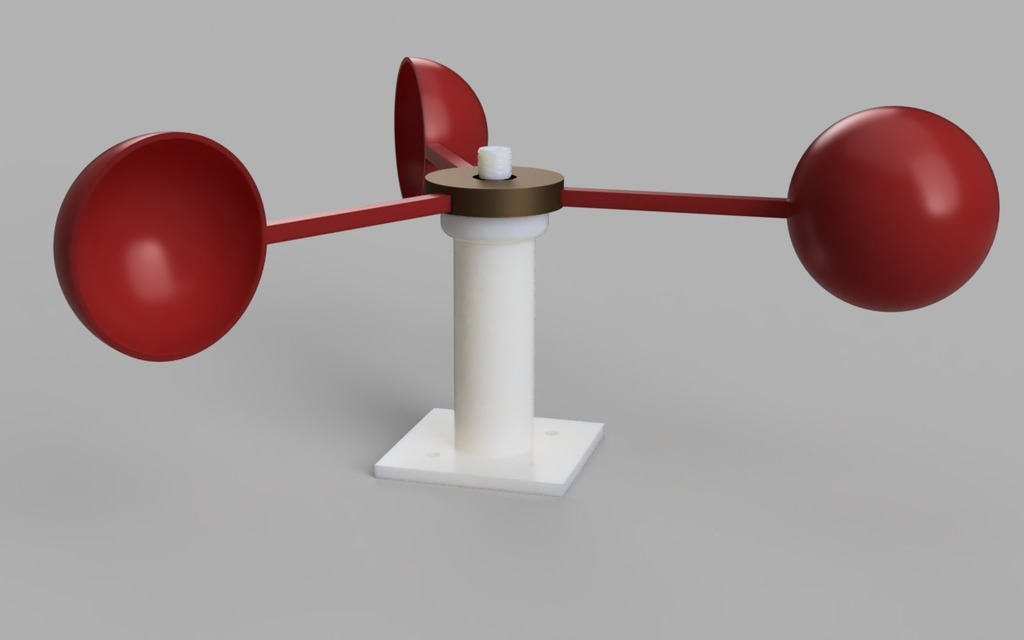
Anemometer w/ Hall Effect Sensor
thingiverse
Note: Work in progress. Will change significantly over the next few weeks. Note that all STLs are in random orientations, not the suggested print orientation. When I have finalized design, I will orient them properly in the final revision. Wind speed sensor for my Arduino weather station. https://www.thingiverse.com/SeanTheITGuy/collections/arduino-weather-station This low-friction anemometer is designed to work with a standard 22x8x7 skate bearing and a bare A3144 Hall Effect Sensor on an arduino-based weather station. It's meant to capture precise wind speed data. <a href="https://www.banggood.com/Hall-Sensor-Brushless-Motor-A3144-A3144E-OH3144E-Capteur-effet-TO-92UA-Interrupteur-3Pin-SIP-p-1007581.html">Hall Effect Sensor</a> <a href="https://www.banggood.com/20pcs-608rs-ABEC-9-Ball-Bearing-Carbon-Steel-Skateboard-Wheel-Bearings-p-1395046.html">22x8x7 608rs Bearings</a> <a href="https://www.banggood.com/100pcs-5mmx2mm-N52-Strong-Round-Magnets-Rare-Earth-NdFeB-Neodymium-Magnets-p-988439.html">5x2 Magnets</a> The sensor mounts in the base, printed side up, glued firmly into place. Attach the 3 wires to the pins using solder or dupont wires. Pass the wires through the bore of the base and out the bottom for a flush mount on top of the box containing the rest of the electronics. I suggest using silicone or hot glue to secure the wires in place and around the wire through-hole, ensuring no water enters the main box and the wires stay put. Adding a gasket or sealant where the flat flange mounts to the main box is also recommended. Depending on the quality of your bearings, you may need an optional spacer washer (STL included) due to excessive lateral play. If the magnets scuff on the sensor face, use the washer; otherwise, skip it. Three holes in the bearing retainer hub require 5x2mm neodymium magnets to be glued in place, triggering pulses on the Hall effect sensor and providing necessary data for the Arduino. Three cups are needed and should be glued into their receivers on the center hub so they catch the wind. Orientation doesn't matter as long as all cups face the same direction around the center axis. Programming for this anemometer, along with other weather-related sensors (barometric pressure, temperature, humidity, wind direction) and a wind vector vane design will be developed over time. <b>2019-03-26 Update:</b> A wind direction vane has been included in this design. It's meant to function with a CJMCU-103 directional angle sensor. <a href="https://www.banggood.com/CJMCU-103-Rotation-Angle-Sensor-Module-SV01A103AEA01R00-Trimmer-10K-Potentiometer-Analog-Voltage-p-1221722.html">CJMCU-103 Angle Sensor</a> This threads onto the top of the base, and wires from the sensor run through the base into the main box to be attached to the NodeMcu. Suggest applying grease to the 22x8x7 bearing for increased weatherproofing in this design.
With this file you will be able to print Anemometer w/ Hall Effect Sensor with your 3D printer. Click on the button and save the file on your computer to work, edit or customize your design. You can also find more 3D designs for printers on Anemometer w/ Hall Effect Sensor.
